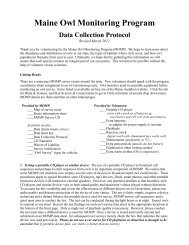Focus Species Forestry - Maine Audubon
Focus Species Forestry - Maine Audubon
Focus Species Forestry - Maine Audubon
You also want an ePaper? Increase the reach of your titles
YUMPU automatically turns print PDFs into web optimized ePapers that Google loves.
Northern Dusky Salamander<br />
Distribution: Southern Quebec, south to Alabama;<br />
apparently absent northeast of Presque Isle, <strong>Maine</strong><br />
<strong>Maine</strong> <strong>Focus</strong> Region: Statewide<br />
Home Range: Variable, 15-500 sq. ft.<br />
Food: Feeds mainly at night on small aquatic or<br />
terrestrial insects, crustaceans and other invertebrates<br />
Special Habitat Needs: Cool, clear seeps; intermittent<br />
streams or small perennial streams. Found under rocks or<br />
logs at water’s edge or in the bed of nearly dry streams.<br />
Management:<br />
Use <strong>Maine</strong> Forest Service Best Management Practices to avoid stream sedimentation and maintain<br />
streamside vegetation for shade, cover, and habitat for adult forms of aquatic insects.<br />
See riparian and wetland forest recommendations (Section 5).<br />
Comments: Dusky salamanders are found high in the watershed above the range of brook trout and other fish.<br />
They are about 2.4-4.3 in. long, gray or brown, and frequently mottled. Duskies are frequently found in the<br />
company of two-lined salamanders but, unlike the two-lined, are intolerant of warm water and sediment. In the<br />
western mountains region, northern spring salamanders may be encountered more frequently than duskies in<br />
headwater streams. Dusky salamanders winter 12-20 in. below ground near streams. Insects associated with these<br />
small streams are prey for birds, and the cool, clear water sustains streams lower in the watershed that are critical<br />
for trout and other fish.<br />
Habitat Use<br />
Aspen-Birch<br />
Forest Ecosystems<br />
Northern<br />
Hardwoods Oak-Pine Hemlock Spruce-Fir<br />
N. White<br />
Cedar<br />
R S I M R S I M L R S I M L I M L R S I M L I M L<br />
Special-value<br />
Habitats<br />
Riparian/<br />
Wetland Vernal<br />
Forest Pool<br />
R Regeneration and seedlings Mx Mixed conifer-deciduous <strong>Focus</strong> habitat<br />
S Saplings and small poles U Understory present Other habitat<br />
I Intermediate-aged forest C Cavity tree or snag Little/no use<br />
M Mature forest<br />
L Late-successional forest<br />
References: Barbour et al. 1969, DeGraaf and Yamasaki 2001, <strong>Maine</strong> Forest Service 1992, Markowski 1999<br />
<strong>Focus</strong> <strong>Species</strong> <strong>Forestry</strong> 55



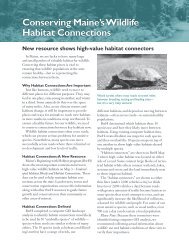
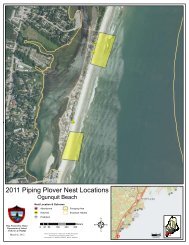
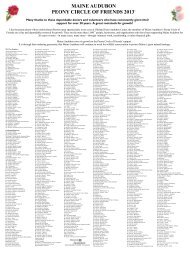
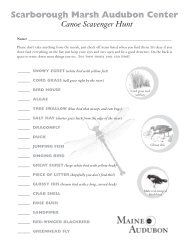


![2012 Loon Count Results [pdf] - Maine Audubon](https://img.yumpu.com/26228732/1/190x245/2012-loon-count-results-pdf-maine-audubon.jpg?quality=85)
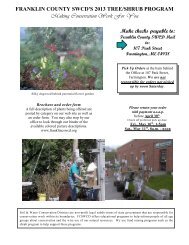
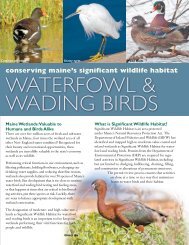
![Lake Fish of Maine (DIFW list) [pdf] - Maine Audubon](https://img.yumpu.com/23282964/1/190x245/lake-fish-of-maine-difw-list-pdf-maine-audubon.jpg?quality=85)
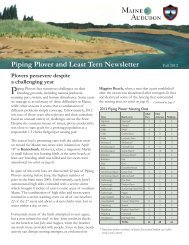

![The Maine Audubon Peony Circle of Friends 2012 [pdf]](https://img.yumpu.com/22707677/1/190x253/the-maine-audubon-peony-circle-of-friends-2012-pdf.jpg?quality=85)
